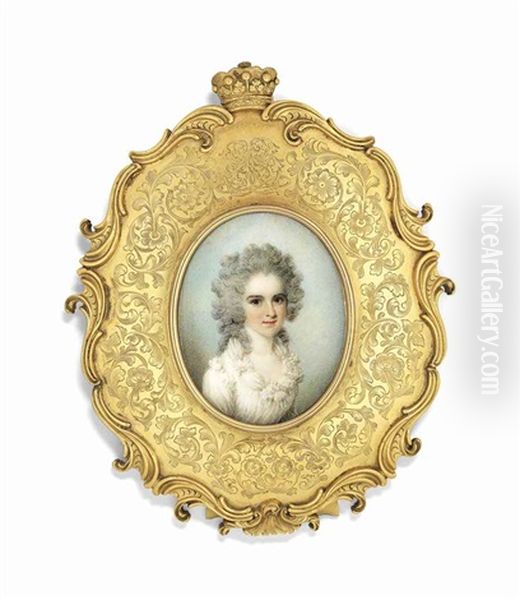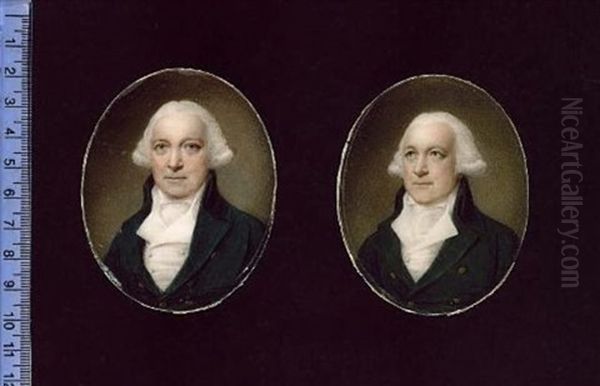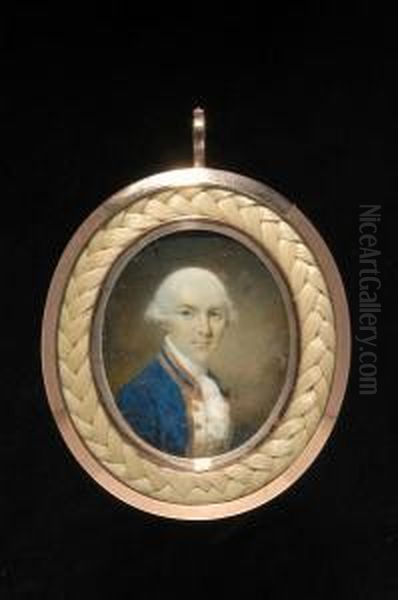Samuel Shelley stands as a significant figure in late eighteenth and early nineteenth-century British art. Active during a vibrant period of artistic development, Shelley carved a distinct niche for himself primarily as a painter of exquisite portrait miniatures and graceful watercolour compositions. Born in London in 1750 and passing away there in 1808, his career spanned a crucial era that witnessed the consolidation of the Royal Academy's influence alongside the burgeoning status of watercolour as a serious artistic medium. Shelley was not only a successful practitioner, exhibiting regularly at the Academy, but also a key player in advocating for watercolour, becoming a founding member of the Society of Painters in Water Colours.
Early Life and Artistic Formation
Samuel Shelley was born in Whitechapel, London, into an era where the city was solidifying its status as a major European art centre. While details of his earliest training remain somewhat obscure, a pivotal moment came in 1774 when he enrolled in the prestigious Royal Academy Schools. This institution, founded just a few years earlier in 1768 with the celebrated Sir Joshua Reynolds as its first President, was the epicentre of artistic education and exhibition in Britain.
Studying at the Academy provided Shelley with rigorous training in drawing from casts and the life model, grounding him in the neoclassical principles favoured at the time. Crucially, it exposed him to the work and teachings of leading artists. The influence of Sir Joshua Reynolds, known for his 'Grand Manner' portraits that imbued sitters with grace and status, is discernible in Shelley's subsequent work, particularly in the elegance and compositional poise of his figures, albeit translated to a more intimate scale.
The Rise of a Miniaturist
While Shelley worked in watercolour on a larger scale, he achieved particular renown for his portrait miniatures. This art form, involving intricate painting on small surfaces like ivory or vellum, was highly fashionable for personal keepsakes and intimate gifts. Shelley excelled in capturing not just a likeness but also the character and sensibility of his sitters, often favouring depictions of women and children, whose grace and innocence suited his delicate style.

His miniatures are characterized by refined draughtsmanship, subtle modelling of features, and a harmonious use of colour. He competed in a field populated by other talented miniaturists such as Richard Cosway, known for his dazzling, fluid style, and George Engleheart, noted for his prolific output and solid likenesses, as well as Andrew Plimer. Shelley's work, however, often possessed a distinct sweetness and gentle sentiment that appealed greatly to patrons.
Examples like his 1783 miniature of the famous actress Sarah Siddons, now housed in the Metropolitan Museum of Art, showcase his ability to convey personality within the demanding constraints of the format. Another notable example is the portrait of Eleanor Countess of Lauderdale, held by the Victoria and Albert Museum, which exemplifies the elegance and refined sensibility typical of his mature miniature style from the early 19th century.
Expanding Horizons: Watercolour and Imaginative Subjects
Beyond the intimate world of miniatures, Samuel Shelley was also a highly accomplished watercolourist. He produced not only watercolour portraits but also 'fancy pictures' – imaginative or sentimental subjects often drawn from literature, mythology, or allegory. These works allowed him greater freedom in composition and narrative than traditional portraiture.
His watercolour technique was typically delicate, often employing careful washes combined with stippling or hatching to achieve subtle gradations of tone and texture. While perhaps not possessing the revolutionary atmospheric breadth of contemporaries like Thomas Girtin or J.M.W. Turner, who were primarily landscape painters, Shelley brought a figure painter's sensibility to the medium, focusing on narrative clarity and graceful forms.
A masterpiece combining his skill in portraiture with allegorical themes is The Hours (1801), another gem in the Metropolitan Museum of Art's collection. This larger watercolour miniature depicts three female figures representing aspects of time (Eunomia, Past, Ephemeris), showcasing his ability to handle complex compositions and imbue them with neoclassical grace and charm. His work sometimes also referenced major oil painters, as seen in his miniature of Captain George K. H. Coussmaker, which skillfully captures details from Sir Joshua Reynolds's famous large-scale equestrian portrait.
The Royal Academy and the Status of Watercolour
Throughout his career, Shelley maintained a connection with the Royal Academy, exhibiting his works there regularly for three decades after his admission as a student. The Academy's annual exhibitions were the premier showcase for artists in Britain, offering crucial visibility and potential patronage. However, the Academy traditionally prioritized oil painting and sculpture – the 'higher' forms of art.

Watercolour painting, despite its growing popularity and the emergence of highly skilled practitioners, was often relegated to a secondary status within the Academy's structure and exhibitions. Drawings and watercolours were typically displayed in less prominent spaces, and artists working primarily in watercolour found it harder to achieve full Academician status. This perceived lack of recognition and respect for the medium was a source of frustration for many watercolour specialists.
This context is crucial for understanding Shelley's next significant contribution to British art history. His own success, particularly with imaginative watercolours that might not have fit neatly into the Academy's preferred categories or received prime placement, likely fuelled his desire for a dedicated platform for the medium.
Championing Watercolour: Founding the Society of Painters in Water Colours
The dissatisfaction with the Royal Academy's treatment of watercolour culminated in a pivotal meeting on November 30, 1804, at the Stratford Coffee House on Oxford Street, London. Samuel Shelley was a key figure in this gathering, which led directly to the formation of the Society of Painters in Water Colours (later known as the 'Old' Water-Colour Society or RWS after receiving a Royal charter).
Shelley collaborated closely with other prominent watercolourists who shared his vision. Among the founding members were William Frederick Wells (who became the first President), Francis Nicholson, Robert Hills (a noted animal painter), William Henry Pyne (artist and writer), Nicholas Pocock (known for marine subjects), the landscape painters John Varley and his brother Cornelius Varley, John Claude Nattes, William Sawrey Gilpin, John Glover (who developed a distinctive technique using split brushes), William Havell, Joshua Cristall, and George Barret Jr.
The Society's primary aim was to establish an independent annual exhibition dedicated solely to works in watercolour, allowing the medium to be judged on its own merits and providing its practitioners with a focused showcase. This was a bold and crucial step in elevating the status of watercolour painting in Britain. Samuel Shelley's commitment to the cause was evident in his role as the Society's first Treasurer, managing its financial affairs during its formative period. The first exhibition, held in 1805, was a resounding success, demonstrating the public appetite for watercolour art and the high quality being produced by its members.
Shelley's Artistic Style and Technique Revisited
Shelley's style represents a bridge between the refined elegance of late Neoclassicism and the burgeoning sentiment of early Romanticism. His figures, whether in miniature or larger watercolours, are typically characterized by graceful poses, delicate features, and an air of gentle refinement. His colour palettes are often soft and harmonious, favouring subtle pinks, blues, and creams, applied with considerable technical skill.

In his miniatures, he employed the meticulous techniques required for painting on ivory, using fine brushes to apply watercolour with stippling (tiny dots) and hatching (fine lines) to build up form and tone without disturbing the luminous quality of the ivory base. Gum arabic was often mixed with the pigments to give depth and brilliance to the colours.
In his larger watercolours, while still precise, his handling could be somewhat broader. He adeptly used transparent washes for backgrounds and fabrics, combined with more opaque bodycolour (gouache) for highlights and details, a common practice among watercolourists of the period seeking greater solidity and finish. The influence of Reynolds remained apparent in the compositional grace, but Shelley adapted this to the specific demands and potentials of watercolour and the smaller scale he often favoured. His work stands slightly apart from the more rugged or atmospheric landscape styles being developed by artists like Girtin, Turner, or later members of the OWCS such as David Cox and Peter De Wint.
Later Years and Enduring Legacy
Samuel Shelley continued to work and exhibit until his death in London on December 22, 1808. He remained associated with the Society of Painters in Water Colours, contributing to its early success and helping to establish watercolour as a respected and independent branch of British art. Although perhaps overshadowed in broader art historical narratives by the revolutionary landscape painters or the giants of oil portraiture like Sir Thomas Lawrence, Shelley's contribution was significant within his chosen fields.
His legacy lies in his mastery of the portrait miniature, capturing the likenesses and sensibilities of his era with exceptional delicacy and charm. Furthermore, his role as a founder and early treasurer of the OWCS was instrumental in the professionalization and promotion of watercolour painting. He helped create an institution that would nurture generations of watercolour artists and solidify the medium's importance in the British artistic tradition.
Today, Samuel Shelley's works are held in major public collections worldwide, including the Victoria and Albert Museum and the British Museum in London, and the Metropolitan Museum of Art in New York. These paintings serve as testament to his refined artistry, his technical skill, and his important place in the rich tapestry of late Georgian British art. He remains admired for the elegance, sensitivity, and sheer beauty of his miniatures and watercolours.
Conclusion

Samuel Shelley navigated the London art world of the late 18th and early 19th centuries with considerable success. As a master of the portrait miniature, he captured the faces of his time with intimate grace. As an accomplished watercolourist, he created charming narrative and allegorical scenes. Perhaps most enduringly, as a founding member of the Society of Painters in Water Colours, he played a vital role in championing the medium and securing its independent status. His art, characterized by elegance, delicacy, and refined sentiment, continues to be appreciated for its intrinsic beauty and its reflection of the artistic sensibilities of his age. He stands as a key figure connecting the traditions of Georgian portraiture with the burgeoning independence of watercolour art in Britain.